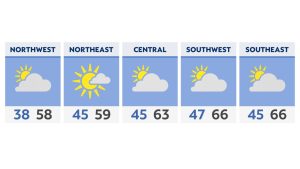OHIO — Mauriel Davis always had a close bond with her mother, Rhonada Perry.
“That was us,” she said, pointing to a photo of the two of them. “That was my girl.”
A 2014 photoshoot showcases their mother/daughter relationship.
Family memories can be found all throughout Davis’ home.
“These are in honor of her,” Davis said. “These are also so my children can walk past and remember their Granny.”
The two became even more connected after they both were diagnosed with triple-positive breast cancer less than a week apart.
“My mom was diagnosed on April 17, 2012 and I was diagnosed on April 23, 2012.” said Davis.
Davis was 29 at the time and her mother had just turned 50.
“At first she didn’t choose to do the chemotherapy,” she said. “So, she just got a mastectomy on the one side that the cancer was at, but then two years later it came back and it went to her brain.”
Perry died in 2016.
“By the time she decided to go with what the doctors ordered and take the chemo, it was probably already a little too late,” Davis said.
According to data from the American Cancer Society, Black women have a 40% higher death rate from breast cancer compared to white women.
“A lot of Black women, when you compare them to white women or other races, they don’t follow through 100% with treatment,” Davis said. “They’ll start treatment and not come back, or they won’t go get their mammograms and things like that.”
Cleveland Clinic Medical Oncologist Dr. Azka Ali said there are many complicated and intertwined variables that cause these racial disparities, but that large gap in mortality rates really grew in the 80s.
“In the 80s, when we started incorporating mammography screening and approval of anti-estrogens or drugs that are typically described as endocrine therapies, that’s when we really noticed that difference in, in mortality, because that’s when we really can appreciate that difference in access to mammography screenings and difference in access to prescription drugs,” Ali said. “And that gap has really not been able to be closed even, you know, 30-40 years later, unfortunately.”
Ali said it comes down to both genetic and socioeconomic factors.
“Poverty alone is a risk factor in terms of cancer related mortalities, especially breast cancer related mortality,” Ali said. “We know that more African Americans live at or below poverty level than white people in the U.S., and more African American women, they tend to be under screened and they tend to present with more advanced disease.”
Another issue is a lack of representation in clinical trials that are predominantly conducted with white patients.
“We study the drugs and approve the drugs and that’s how we moved the science forward,” Ali said. “But we don’t really know if the drugs are working as well in our underrepresented minorities and in our Black patients.”
Davis’ children were her motivation to follow through with her treatment plan, which included chemo and a double mastectomy.
Her daughter was three-years-old and her son was seven-years-old when she was diagnosed.
“I wanted to do whatever it took to still be here for my kids,” she said. “I didn’t want to reject things that were offered to me and then it would be my fault that I’m not here to see my kids get older.”
The proud mom said she is grateful to be able to be here to watch her children grow up. And no matter how much time passes, Davis plans to keep reminders nearby of what she went through alongside her mom.
“This is my dump truck company,” she said, pointing to her work T-shirt. “And I actually named it ‘Pink Angels Dumping’ in honor of my mother.”
Davis also gives back by supporting others battling breast cancer through her nonprofit “Sow Into Patients” or SIP. She hopes to encourage other women to advocate for their health.
“My mission here and the reason my life was, I think, spared was to pour into other women,” Davis said.




